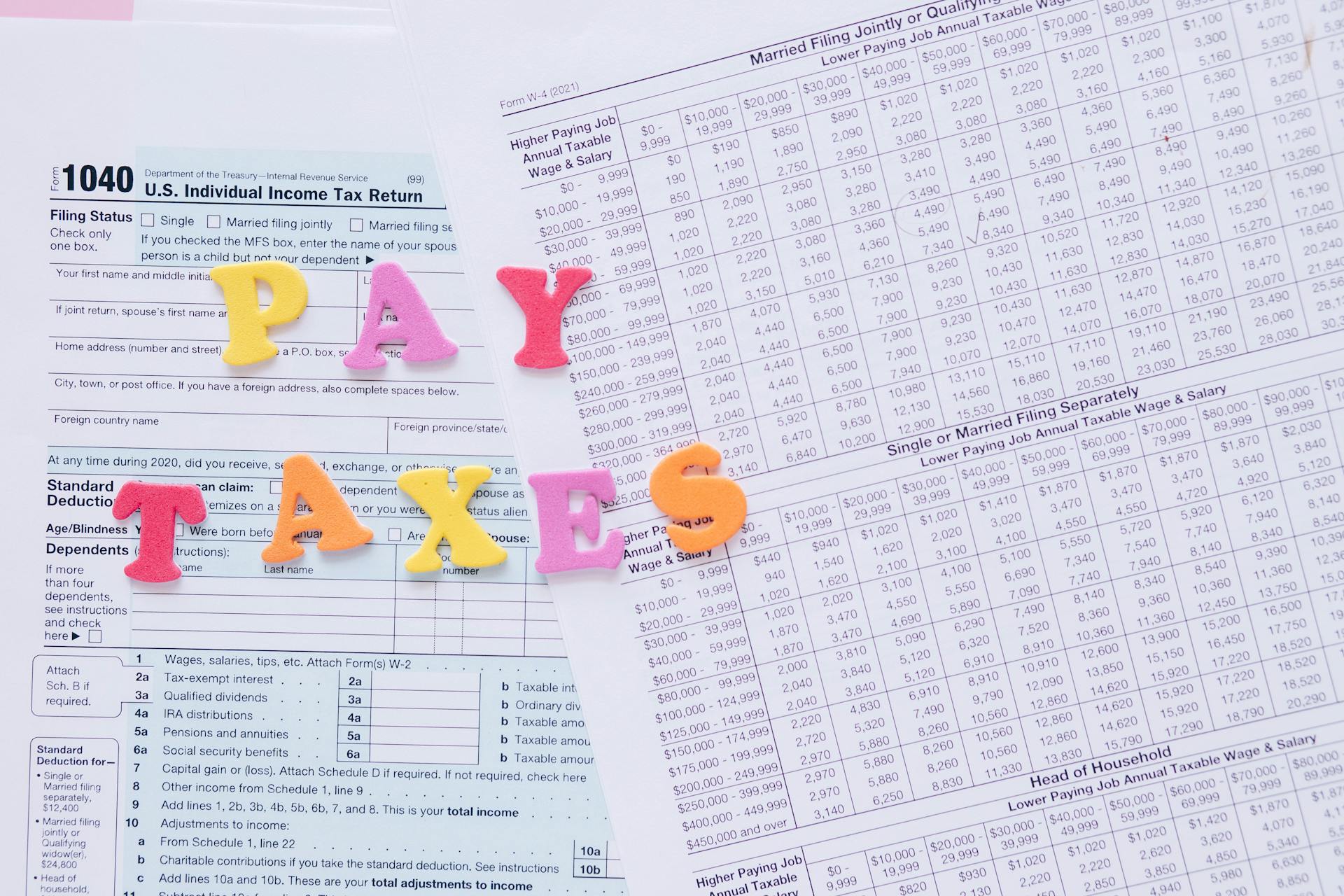
Deferred annuity taxation can be a complex topic, but understanding the basics can help you make informed decisions about your financial future.
The key benefit of a deferred annuity is that it allows you to delay paying taxes on your investment gains until you withdraw the money, typically in retirement. This can be a huge advantage for individuals who expect to be in a lower tax bracket in retirement.
You can choose from two main types of deferred annuities: fixed and variable. Fixed annuities offer a guaranteed interest rate, while variable annuities allow you to invest in a range of assets and potentially earn higher returns.
The IRS considers a portion of your annuity payments as taxable income, and you'll need to report this on your tax return.
Additional reading: Who Assumes the Investment Risk with a Fixed Annuity Contract
Annuity Taxation Basics
Deferred annuities grow on a tax-deferred basis, meaning you won't pay taxes on the earnings until you withdraw the money.
You'll pay taxes only when you make withdrawals, take a lump sum, or begin receiving income from the account.
The tax rate you'll pay on withdrawals is your ordinary income tax rate.
Before buying a deferred annuity, it's essential to have enough money in a liquid emergency fund to cover unexpected expenses.
Deferred annuities should be considered long-term investments, so try to avoid tapping into them unless absolutely necessary.
A unique perspective: Bonus Tax Rate
Tax Implications of Annuity Payments
If you contributed after-tax dollars to your pension or annuity, your pension payments are partially taxable. This is because the part of the payment that represents a return of the after-tax amount you paid is tax-free.
You won't pay tax on the tax-free part of your pension payment, which includes the amounts your employer contributed that were taxable to you when contributed. This can be a significant relief for many retirees.
Taxpayers figure the tax on partly taxable pensions by using either the general rule or the simplified method. If the starting date of your pension or annuity payments is after November 18, 1996, you generally must use the simplified method.
See what others are reading: Pension House
You may be subject to an additional 10% tax on early distributions if you receive pension or annuity payments before age 59½. This extra tax doesn't apply to any part of a distribution that's tax-free or to certain types of distributions, such as those made as a part of a series of substantially equal periodic payments.
The following types of distributions are exempt from the additional 10% tax:
- Distributions made as a part of a series of substantially equal periodic payments that begins after your separation from service.
- Distributions made because you're totally and permanently disabled.
- Distributions made because you're terminally ill.
- Distributions made on or after the death of the plan participant or contract holder.
Owners of deferred annuities pay taxes only when they make withdrawals, take a lump sum, or begin receiving income from the account. At that point, the money they receive is taxed at their ordinary income tax rate.
Taxation of Annuity Withdrawals
You can expect to pay taxes on annuity withdrawals, but the good news is that you won't pay taxes on the part of the withdrawal that represents a return of the after-tax amount you paid. This amount is your investment in the contract and includes the amounts your employer contributed that were taxable to you when contributed.
Related reading: 457b Distribution
If you receive pension or annuity payments before age 59½, you may be subject to an additional 10% tax on early distributions, unless the distribution qualifies for an exception. This means you'll need to pay an extra 10% tax on top of your regular income tax rate.
To figure out how much of your annuity payment is taxable and how much is tax-free, you'll generally need to use the simplified method if your starting date of pension or annuity payments is after November 18, 1996.
You can avoid paying taxes on early distributions in certain situations, such as if you're totally and permanently disabled, or if the distribution is made as a part of a series of substantially equal periodic payments that begins after your separation from service.
The types of exceptions to the additional 10% tax can be found in Publication 575, Pension and Annuity Income and Instructions for Form 5329, Additional Taxes on Qualified Plans (Including IRAs) and Other Tax-Favored Accounts.
Here are some exceptions to the additional 10% tax on early distributions:
- Distributions made as a part of a series of substantially equal periodic payments that begins after your separation from service.
- Distributions made because you're totally and permanently disabled.
- Made to you because you're terminally ill.
- Distributions made on or after the death of the plan participant or contract holder.
Things to Consider
When you're considering a deferred annuity, it's essential to think about how taxes will fit into the picture. You pay taxes only when you make withdrawals, take a lump sum, or begin receiving income from the account.
This tax delay can be a big advantage, especially if you're trying to minimize your tax liability. You won't have to worry about taxes eating into your retirement savings until you're actually using the money.
You'll be taxed on the money you receive at your ordinary income tax rate, so keep that in mind when planning your withdrawals.
Take a look at this: Tax Rate on Inherited Ira
Things to Know About Buying Fixed Annuities
Fixed annuities promise a specific, guaranteed rate of return on the money in the account. This means you'll know exactly how much interest you'll earn, which can be a big comfort for those who value predictability.
Before buying a fixed annuity, make sure you have enough money in a liquid emergency fund. This will ensure you can cover unexpected expenses without having to tap into your annuity.
If this caught your attention, see: Borrowing Money from 401k
The period when you're paying into a fixed annuity is known as the accumulation phase. This is the time when your money grows tax-deferred, meaning you won't have to pay taxes on it until you make withdrawals.
Fixed annuities are considered long-term investments. This means you should be prepared to keep your money in the annuity for a while, rather than expecting to withdraw it quickly.
You'll pay taxes on a fixed annuity only when you make withdrawals, take a lump sum, or begin receiving income from the account. At that point, the money you receive is taxed at your ordinary income tax rate.
If this caught your attention, see: What Is the Tax Rate on Inherited Ira Withdrawals
Annuity Gotchas
High fees are a major disadvantage of annuities, including surrender charges that can be costly.
These fees can eat into your retirement savings, leaving you with less money to live on.
Annuities are complex and sometimes difficult to understand, which can lead to confusion and poor decision-making.
On a similar theme: Solo 401k Administration Costs
Strict limits on withdrawals can be a problem, allowing only one withdrawal per year.
Withdrawals may also be subject to surrender fees charged by the insurer, adding to the cost.
If you're under 59½, you'll face a 10% tax penalty on withdrawals, on top of income tax.
You only pay taxes on a deferred annuity when you make withdrawals, take a lump sum, or begin receiving income from the account.
You might enjoy: Vanguard 403 B Services Com Application
Sources
- https://www.irs.gov/taxtopics/tc410
- https://www.doi.sc.gov/598/Buying-Fixed-Deferred-Annuities
- https://www.kiplinger.com/article/insurance/t003-c001-s001-how-annuities-are-taxed.html
- https://www.forbes.com/sites/steveparrish/2019/12/18/the-gotchas-in-annuity-taxation/
- https://www.investopedia.com/terms/d/deferredannuity.asp
Featured Images: pexels.com


